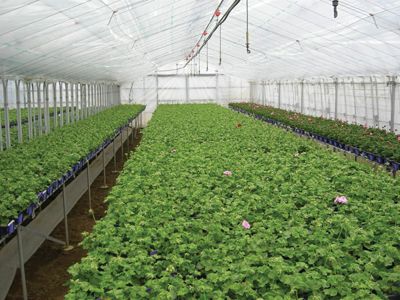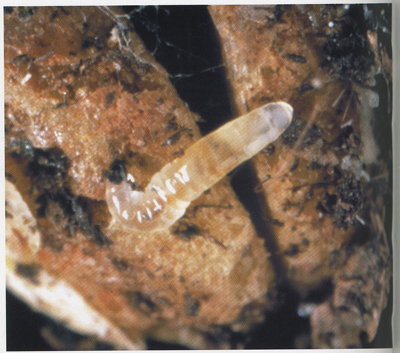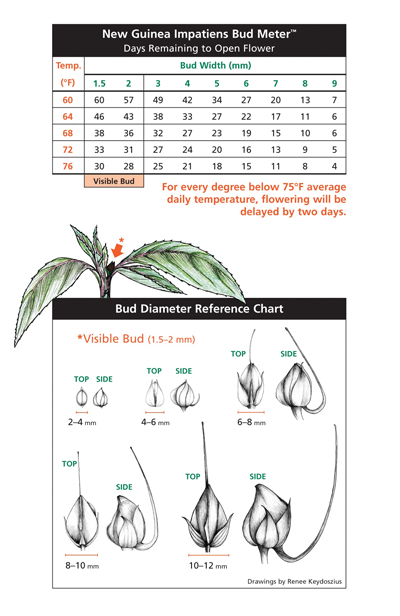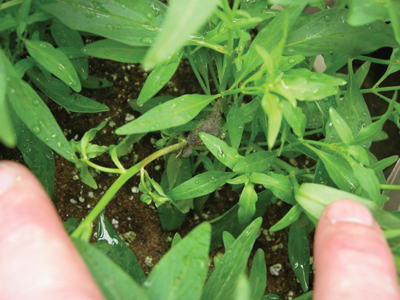
Managing crops to yield maximum profitability should be on the top of
every grower’s list of goals and objectives. Borrowing a name from the
’90s, this involves applying “best management practices” to all aspects
of production to assure maximum success
Managing crops to yield maximum profitability should be on the top of every grower’s list of goals and objectives. Borrowing a name from the ’90s, this involves applying “best management practices” to all aspects of production to assure maximum success; however, that “success” is defined. Looking specifically at inputs that have the greatest impact on the cost of production, labour and energy are at the top. And with rising energy costs impacting profitability in particular these past few years, it makes sense to apply best management practices towards reducing this cost.
 |
|
| Avoid hanging baskets, if possible – they will block the light. Advertisement
|
Energy-efficient strategies go beyond turning down the greenhouse thermostat to control and reduce costs and resources. A good strategy requires thorough assessment of which crops can be successfully produced with less energy without compromising quality. From a review of the planned crop rotation in any greenhouse there should result a list of crops that encompass all the following possibilities:
- Cold crops
- Warm crops grown cold
- Crops grown in less time.
Cold crops are those that either require or tolerate cold temperature production. Crops like cyclamen, pansies and violas, petunias, osteospermum and others are good examples of crops that easily fall into a cold crop production program. In fact, this list can be quite extensive when considering the range of annuals, perennials and potted flowering crops that fit into this categorization. Just to be clear, these are crops that do well at temperatures falling within an average daily temperature range of 50 to 55˚F / 10 to 13˚C.
 |
|
| If growing cool, monitor irrigation to help avoid problems from fungus gnat larvae |
With the spring crops, growers have the distinct advantage of production starting in winter when days and nights are the coldest, and providing a constant cold-temperature growing environment does not present a challenge. Unfortunately, this is also a period of time when days are the shortest and light levels are limited, so good production management is required to mitigate the factors that limit plant growth; more about that will be discussed later in this article.
Warm crops grown cool presents another opportunity to reduce energy consumption and lower the cost of production. Here we can consider how adaptable a species may be to a cooler environment and if the resulting growth can still meet specifications for size and delivery dates. The list of crops that may fit this strategy is shorter than the list of cold crops possible, but on this list are some large-volume species that can have a significant impact on the bottom line for any operation producing them.
Two prime candidates to evaluate are poinsettias and geraniums.
In the case of poinsettias, there has been a lot of good practical research and experience gained over the past few years reducing average daily temperatures without problems of quality or timing causing losses. With the tools available to growers today, such as OnTarget® graphical tracking and The Ecke Poinsettia Bract Meter®, risks of missing specifications for height and delivery dates have been greatly reduced, making it feasible for any grower to manage this crop and save 20 to 25 per cent of the energy required. When you look at the greenhouse space represented by poinsettias, this savings could be very significant!
The other example identified is geraniums. Growers have produced this crop with less energy for many years and some still do so very successfully. Like poinsettias, this can represent a lot of greenhouse space and potential savings!
 |
In both of the strategies outlined previously, adjustments to culture protocols are required compared to traditional culture to be successful. The most important considerations are as follows:
- Variety Selection: In both examples, variety selection is critical in the success of a cold temperature growing program. In the poinsettia world, breeders have done a good job of identifying which of the varieties sold can be grown with less energy. However, not all breeders agree on what strategy of low temperatures is best! We (Ecke) support the idea of using cool temperatures throughout the crop during production, while others advocate growing the crop warm up until late stages of development. Be sure to decide which strategy will be used in order to plan the production schedule (see below)! With geraniums, series or varieties that have more vigour are better adapted to being grown with less energy. Compact varieties are not aggressive enough to do well in this production without an excessive number of extra days added to production.
ROOTING IS NOT THE STAGE TO TRY TO SAVE ON ENERGY
- PROPAGATION: Rooting is not the stage of production to try to save energy! Because product is at high density, the cost of heating is not expensive on a per unit basis and anything that would compromise root development will result in additional costs later on.
- SCHEDULING: Lower temperatures for production result in slower growth, so adjustments in the scheduling are required. Depending on the pot sizes being produced, the additional time required can vary from one to three extra weeks. Small pots that dry out quickly are the least affected by colder temperatures. Larger pots and baskets with a higher volume of soil may require a minimum of two extra weeks of growth in order to produce a quality finished plant. Adjustments will also be required based on the size of plug or liner growers start with! (Figure 1)
- IRRIGATION: Arguably, this is the most important crop function to be managed! In order to avoid root diseases and insect pest problems such as fungus gnat larvae, attention must be given to providing adequate drying between irrigations. Not only does the frequency of irrigation need to be reduced, but the volume of irrigation solution should also be reduced to prevent over-saturation of the soil.
- FERTILIZATION: Adjustments in irrigation influence adjustments in fertilization. With fewer opportunities to supply fertilizer to the crop, growers will need to increase the concentration of the fertilizer to compensate. Close monitoring of pH and EC must be routine to keep nutrient levels within required parameters. With cooler temperatures, there is less tolerance of using ammonium or urea form nitrogen that could result in ammonium toxicity.
- LIGHT: Crops grown with less energy should be provided optimum light conditions that could compromise growth. Do not grow cold in greenhouses that are full of hanging baskets that will reduce the light penetrating to the lower levels of the greenhouse where crops are grown.
- PLANT GROWTH REGULATORS: Cool temperature production will reduce the need for PGR treatments; however, it will not eliminate this need! In the early stages of development slower plant growth will require little, if any, PGR to maintain plant shape and form. However, as the conditions improve due to longer days and warmer average temperatures in the later stages of growth, plants will most likely start growing (stretching) aggressively. Be prepared to apply appropriate PGRs in the mid to late stages of development to prevent uncontrolled growth that could compromise quality.
- INSECT/DISEASE MANAGEMENT: Cooler temperatures will help suppress some of the insect pest pressure growers need to manage, but like PGRs, these pressures will rapidly change in the late stages of development due to warmer, longer days. Good IPM practices should help in preventing outbreaks at the time plants should be delivered to retail markets. Disease pressures will be influenced by how effectively foliage and soil moisture levels can be managed. As already stated, keeping the growing media dry is a critical factor in preventingproblems. Similarly, keeping foliage dry will also help prevent outbreaks of various fungal diseases that could rapidly damage these crops.
- Crops grown in a shorter period of time is another of the strategies to be evaluated. Simply put, if the number of days on the bench can be reduced, so can energy inputs associated with that crop. In the case of spring crops, reducing crop time can save a significant amount of energy, as it keeps plants out of the greenhouse during the coldest and most energy intense period of the season.
 |
|
| Checking New Guinea impatiens bud development.
|
To grow crops in less time, growers can use several approaches. One of the easiest is to start with larger plugs or liners, or even prefinished plants that required anywhere from five to seven weeks less production time. Yes, the cost of these larger plants to start with is higher, but when the calculations are done to compare this against the total energy cost associated with starting from unrooted cuttings or smaller plugs/liners, growers may be very surprised at the differences in profitability possible.
Another way of reducing bench time is to take advantage of some of the science-based crop programs available in the market. The Ultra Solutions® from Ecke include major crops such as New Guinea impatiens, osteospermum and Regal Geraniums. With the Ultra programs, crop scheduling is broken down into key production stages and variety selection to allow growers to program the crop into flower.
 |
|
| Cool temperatures and wet foliage is a sure recipe for disease; keep foliage dry to prevent problems in the crop.
|
With these examples, not only has it been possible to reduce the average number of weeks required for production (in the case of NGIs, this has gone from 14 to 16 weeks total from URC to 12 weeks), the temperature/days to flower grids provided allow growers to manipulate the flowering based on what is happening with weather conditions and sales targets. If, for example, the spring season is opening up earlier than expected due to good weather conditions (OK, why not give an optimistic example for a change!), growers can determine the precise temperatures needed to force these plants into flower. More realistically for Canadian growers, spring backs up due to cold, rainy weather… these same grids provide clear direction on how cold the temperatures can be in order to hold back the crop and prevent flowers from being open and more at risk for botrytis while waiting for the weather to improve. In this case, not only is energy saved, but losses are greatly reduced by preventing product on the bench from going bad.
The overall quality of plants grown with less energy clearly justifies the efforts required to grow this way. Generally, but not always, bloom size is larger and the flower colour is more intense than in crops grown at warmer temperatures. Stems are thicker, stronger and more durable, which helps prevent damage in transportation. Previously, there have been several distinct strategies outlined for growers to produce in a more energy-efficient way, saving resources and reducing production costs at the same time. ■
Jack Williams is the technical specialist with Ecke Ranch, Ecke Europe and The Flower Fields jwilliams@eckeranch.com .
Print this page